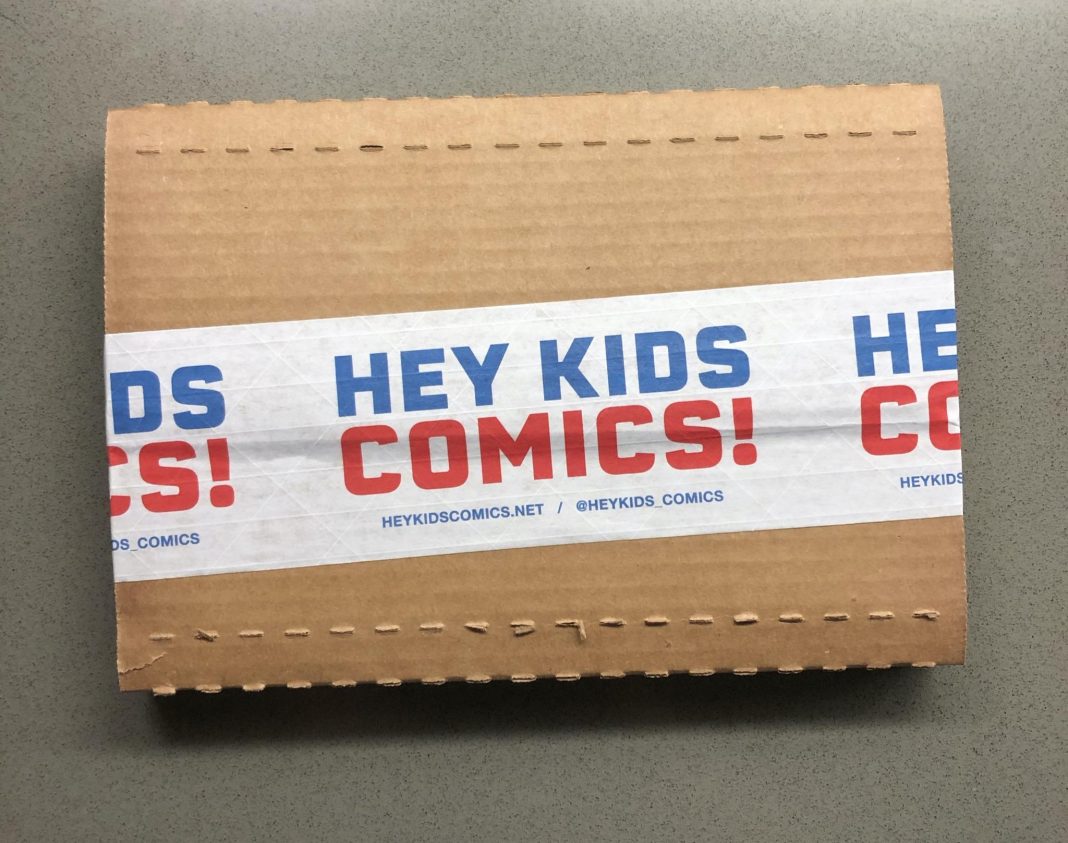By Jason Mojica
One of the most challenging things about running a business is trying to figure out how to make money. Now, of course the goal of any for-profit business is to, you know… turn a profit, and one typically starts a particular kind of business because they find something attractive about the manner in which it generates revenue. But that doesn’t mean the path from idea to income is a straight (or narrow) one.
The dream would be that my days behind the counter at my shop consisted of sipping coffee and reading comics in-between chatting with customers and ringing up thousands of dollars in sales. But it’s never quite that simple, and I knew that going in.
Wait–have I mentioned that this isn’t my first rodeo? In 1997, when I was 23 years-old, I opened a cafe in Chicago called Jinx, followed a year later by a cult & indie video rental shop called Big Brother. Overall I have fond memories of both of those businesses, but the one part that made me miserable were those slow days where I’d sit there looking longingly at the front door, praying for people to come in and make it possible for me to pay for my life. As I weighed the pros and cons of getting back into a brick-and-mortar business, I vowed to work to avoid that particular anxiety by making sure the business wasn’t entirely dependent on in-person sales, as retail stores were back in the days when ecommerce was a but a rumor and the only thing you could do with a mobile devices was make expensive phone calls. This time around I wanted to structure things so that I was actually happy when I had slow days, so I could tend to the other parts of the business.
I just had to figure out what exactly those other parts would be.
In the next few columns, I’ll take you through some of the things I landed on, and share what I’ve learned (as well as what I’m still trying to figure out).
The Hey Kids Comics Club
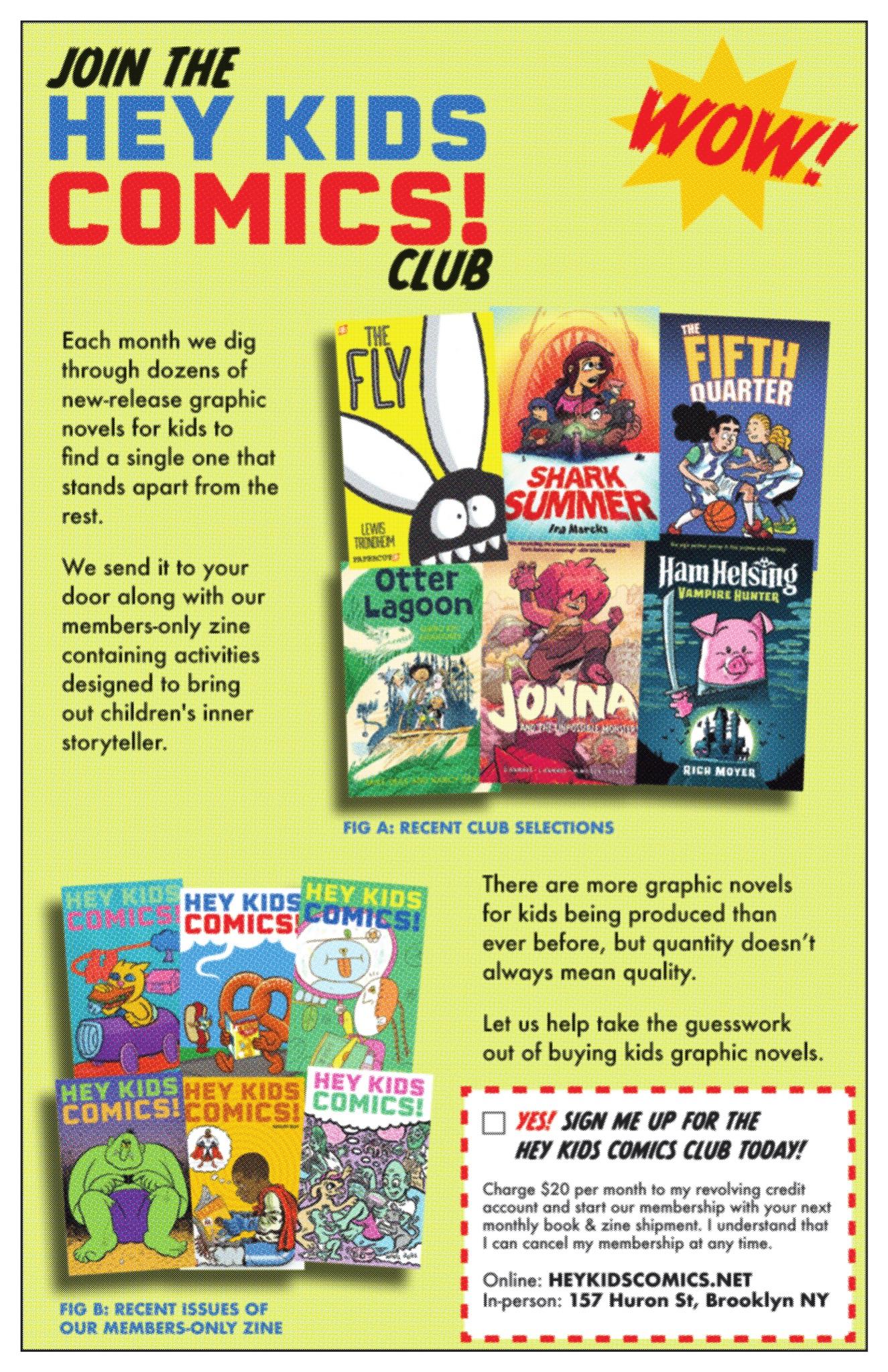
A Bronze Age-style ad for the Hey Kids Comics Club
First up was a subscription box. First because, well, I was already doing it before we opened the shop. My family launched the Hey Kids Comics Club subscription in April 2021 as an extension of what was then just a little sidewalk bookselling operation. Hawking books on the streets when it’s freezing cold out turns out to be rather unpleasant, so I wondered if it was possible to leverage our excellent taste in kids graphic novels into a mail-order business that could serve people all over the USA?
My first experience as a subscription box consumer came when my wife and I received one as a gift following the birth of our son. Each month, it was full of random infant toys and other bits and bobs that somehow the people behind the box knew that infants would be into. It was pretty cool! As he got older, he received Kiwi Crate and Little Passports subscriptions as gifts from relatives, and those were also very cool. Little Passports, if you’re not familiar, opens kids’ minds to the existence of the entire rest of the world (which to my mind is a very good thing), and the Kiwi Crates are full of crafty STEM action.
Anyhow, I wondered if we couldn’t do something that took the guesswork out of buying kids graphic novels. Kind of a, “we sat down and read each and every one of this month’s new kids graphic novels so you don’t have to– here’s our favorite.” I thought the concept was sound, and I thought that book-loving families like ours would like the idea of their kids building a little library of books that they could enjoy again and again. A handsome graphic novel certainly seemed to me like a better subscription box artifact than the graveyard of half-finished Kiwi Crate projects that were piling up in my son’s room.
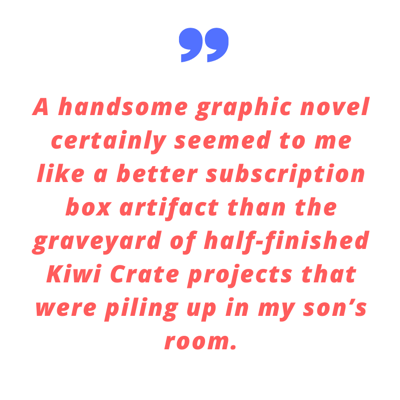
Add shipping to that for a category of books that sometimes seems to be competing on page count, and you’ve got… something that someone could buy from Amazon. For less.
Okay, so if I was to proceed, it couldn’t be a situation where we were competing on price. We would have to add value. But hang on, I couldn’t be the first person to have thought of this. I thought I should see what else was out there.
A quick Google search turned up a bunch of comic surprise boxes comprised of randomly selected floppies, which as we’ve previously discussed, are not necessarily right for kids. Gabe Fowler over at the mind-bendingly amazing Brooklyn shop Desert Island was doing his Mystery Mail subscription–very cool but, again, not for kids. Then I came across the Comix Experience graphic novel club.
Well, shit.
I had heard of Comix Experience, and thanks to each of his Comics Beat columns being discussed in great detail on the More to Come podcast–had heard of Brian Hibbs. Here he was, already doing what I was just beginning to contemplate. So naturally, I signed my son up for a subscription!
It cost $23.25 per month with shipping from CA to NY, and my son and I were both pretty excited about the first package we received: the first volume of the Dav Pilkey’s Cat Kid Comic Club, along with a signed bookplate and a Cat Kid backpack pull. Next up was Oh My Gods, which my son devoured in one sitting. The swag was minimal this time, but there was a live online event with the creators, and… he just wasn’t into it. I thought it was pretty interesting stuff, but the 6 year-old couldn’t be bothered. Next up came a Strange Academy TPB, the writing of which was just kind of over his head, and at that moment, I decided to cancel. It didn’t make a whole lot of sense for me to be paying $23 for a $15 graphic novel that my son wasn’t going to read, when I live in a big city that has comic shops and I’m a comic book enthusiast myself.
So why wasn’t that experience enough to throw cold water on my whole subscription box idea? Well, it did–in a good way. It forced me to think hard about what, if anything, could be done differently. It seemed like there were three variables that could be played with: price, book selection, and the value-add.
Price: This was the most difficult, as the wholesale discounts are what they are. But I realized that the shipping cost could be halved if I used USPS Media Mail instead of Priority. I figured if subscribers get their books at the same time each month it probably won’t matter to them when they were actually shipped. Sure, I’d have to use my own packaging, but that’s also a branding opportunity.
Book selection: I figured that to avoid picking a dud, which could lead to instant cancellation, I’d have to focus on one key age range (6 to 10) and then read every advance copy available with those readers in mind. I would of course let my own snobby opinions of what makes for good comic art & storytelling come into play, but I’d also run my picks past my 6 year-old partner to see if they passed muster. I also realized that a 6 year-old is a lot different than a 10 year-old so trying to find books that manage to appeal to both ends of that spectrum would also narrow the choices.
Value Add: Up to this point, what we were looking at was a product that offers curation & convenience, but is that enough? Probably not. I needed to figure out something that would make it special–something proprietary. That’s when I came up with the idea of publishing a monthly subscriber-only zine. The booklets that came with my son’s Little Passports & Kiwi Crates were, in my opinion, often the best part of those subscription boxes. I grew up reading Highlights, loved making minicomics & zines as a teenager, and later worked as a graphic designer, so putting together a little print publication for kids was well within my skill set and actually sounded like a lot of fun. So yeah, a zine could be just the ticket!
The Hey Kids Comics Zine
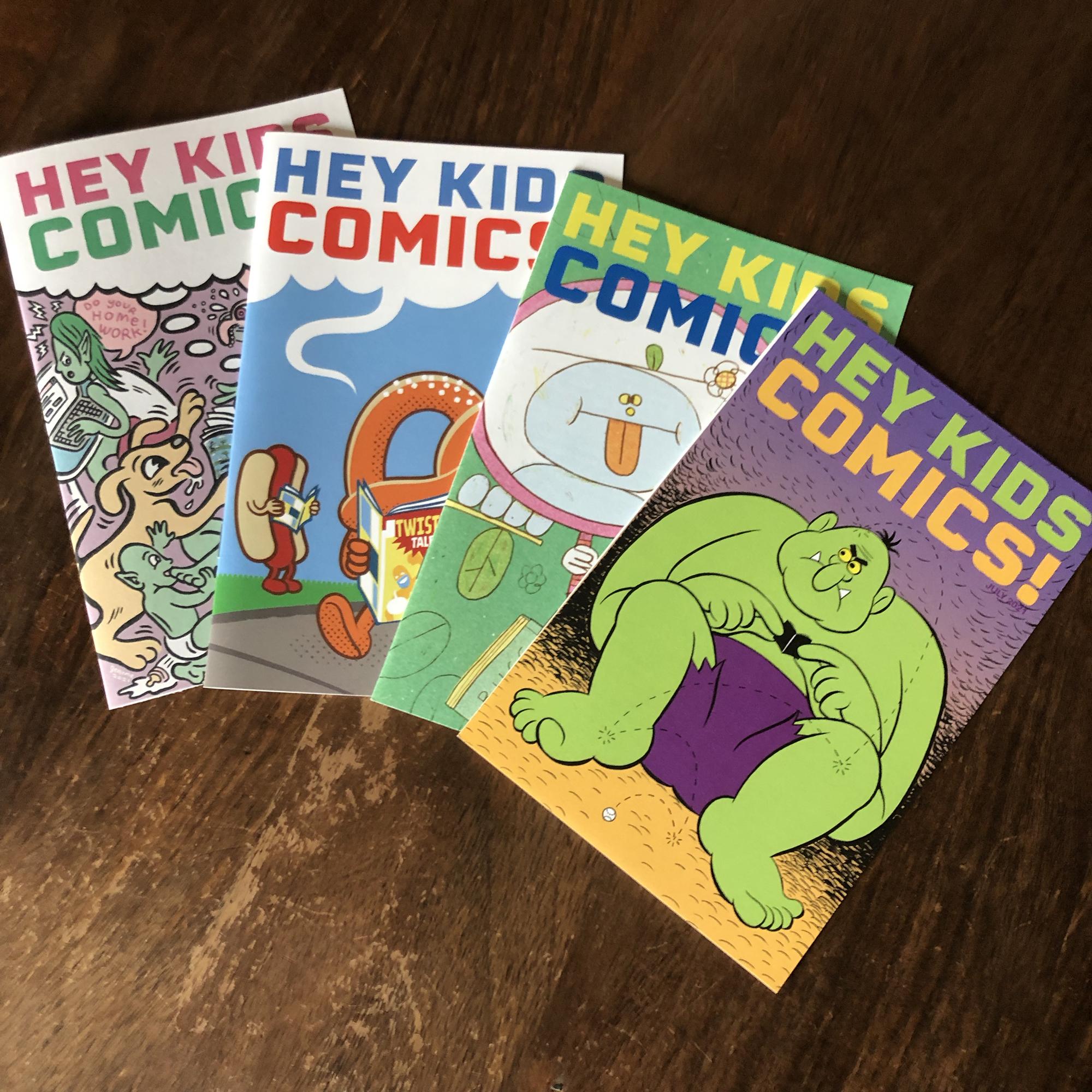
The first four issues of the Hey Kids Comics zine
With the release of the March 2022 issue, we will have 1 year of monthly issues of the Hey Kids Comics Zine under our belt, in which time we’ve worked with some of my favorite artists, including: Juni Ba, James Romberger, Hyena Hell, Johnny Sampson, Josh Bayer, Dan & Jason, Lauren McCallister, Alex Cormack, Nick Gazin, Pia Marchetti, Matt Feazell, Jerome Gaynor, Matthew Shultz, Jim Siergey and many more. But at the beginning, I wasn’t sure it would last more than a few months.
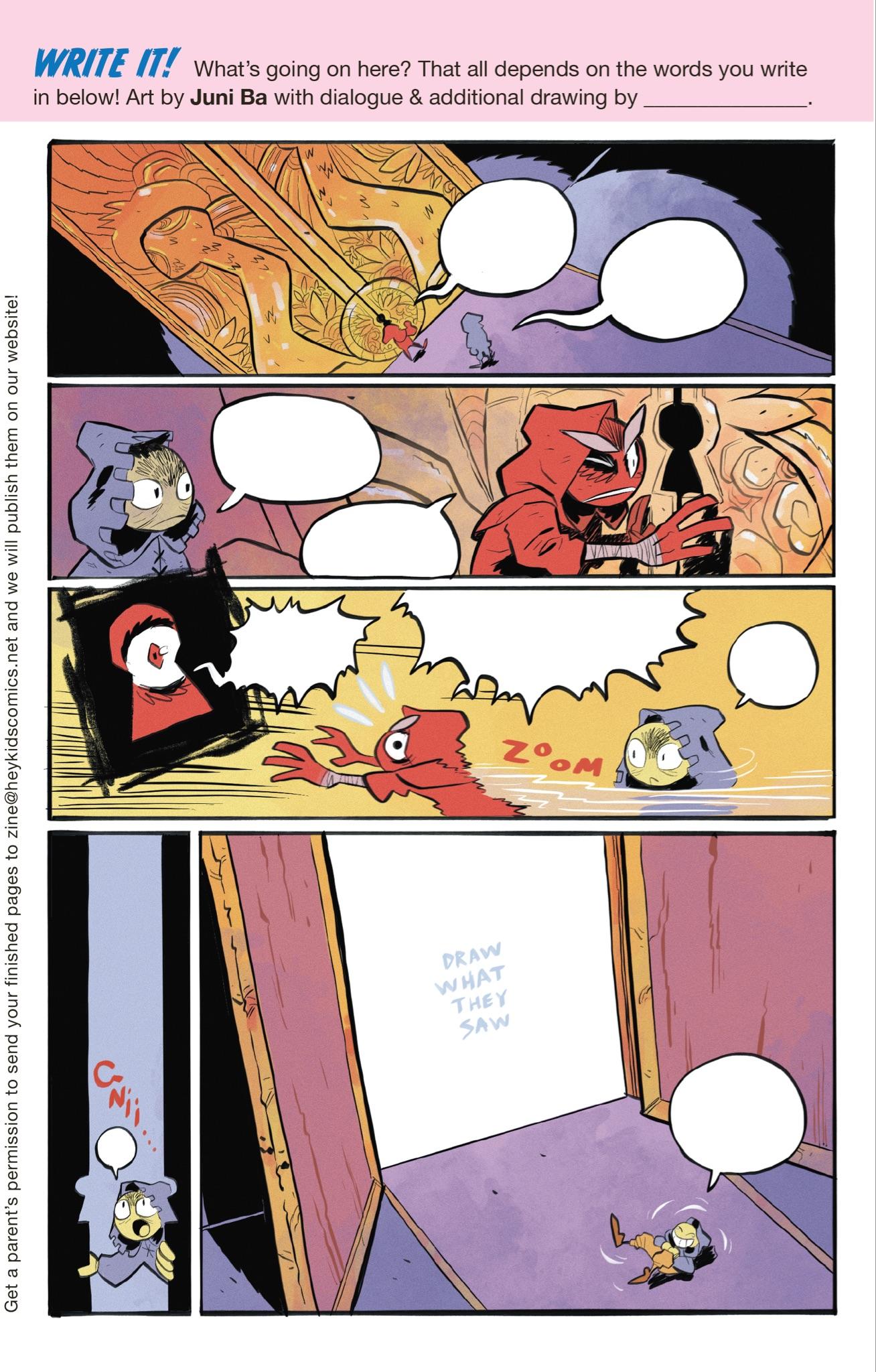
Juni Ba’s contribution to the January 2022 issue of the Hey Kids Comics zine.
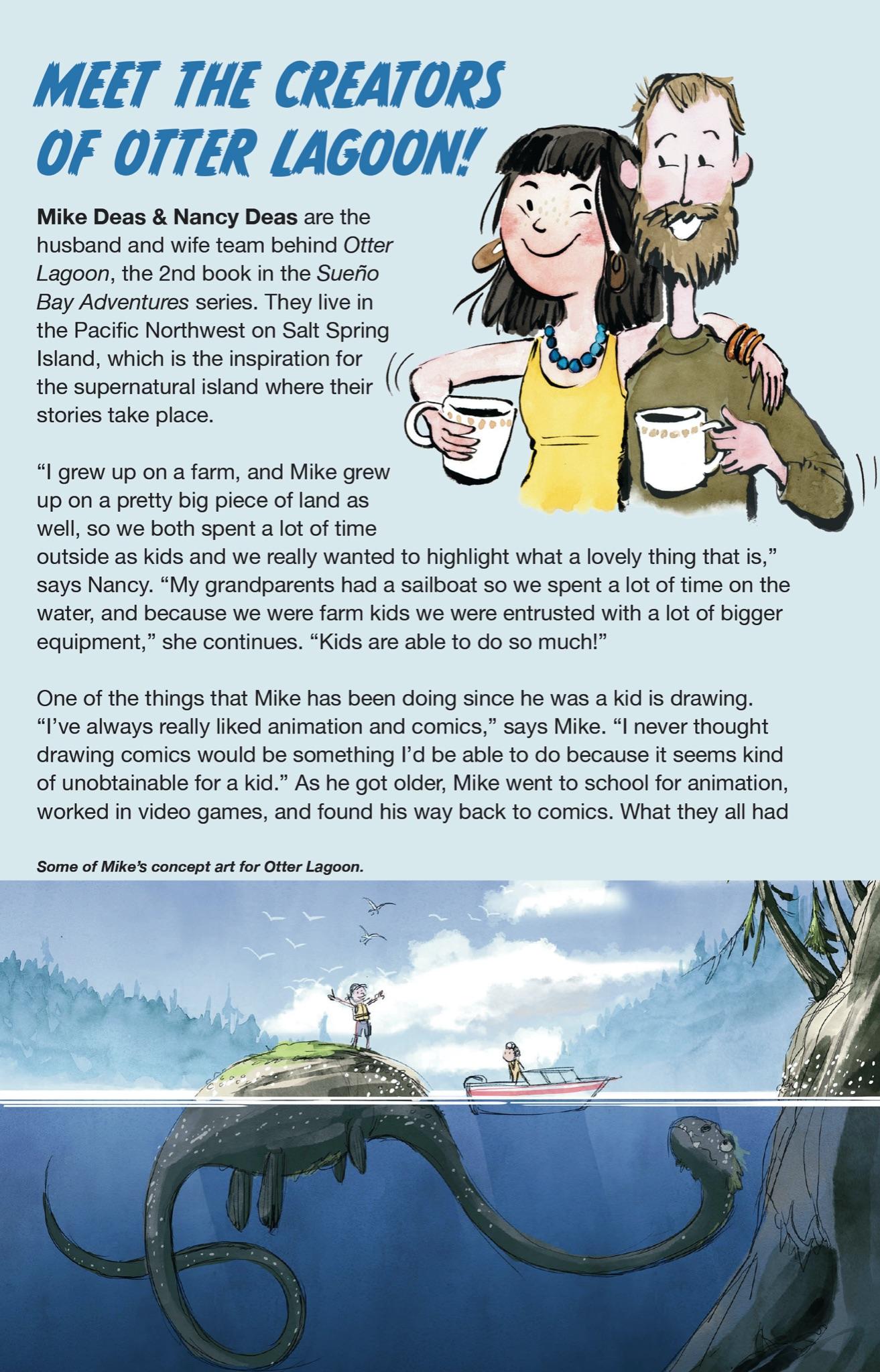
Excerpt from the Meet the Creator feature from the May 2021 issue of the Hey Kids Comics zine
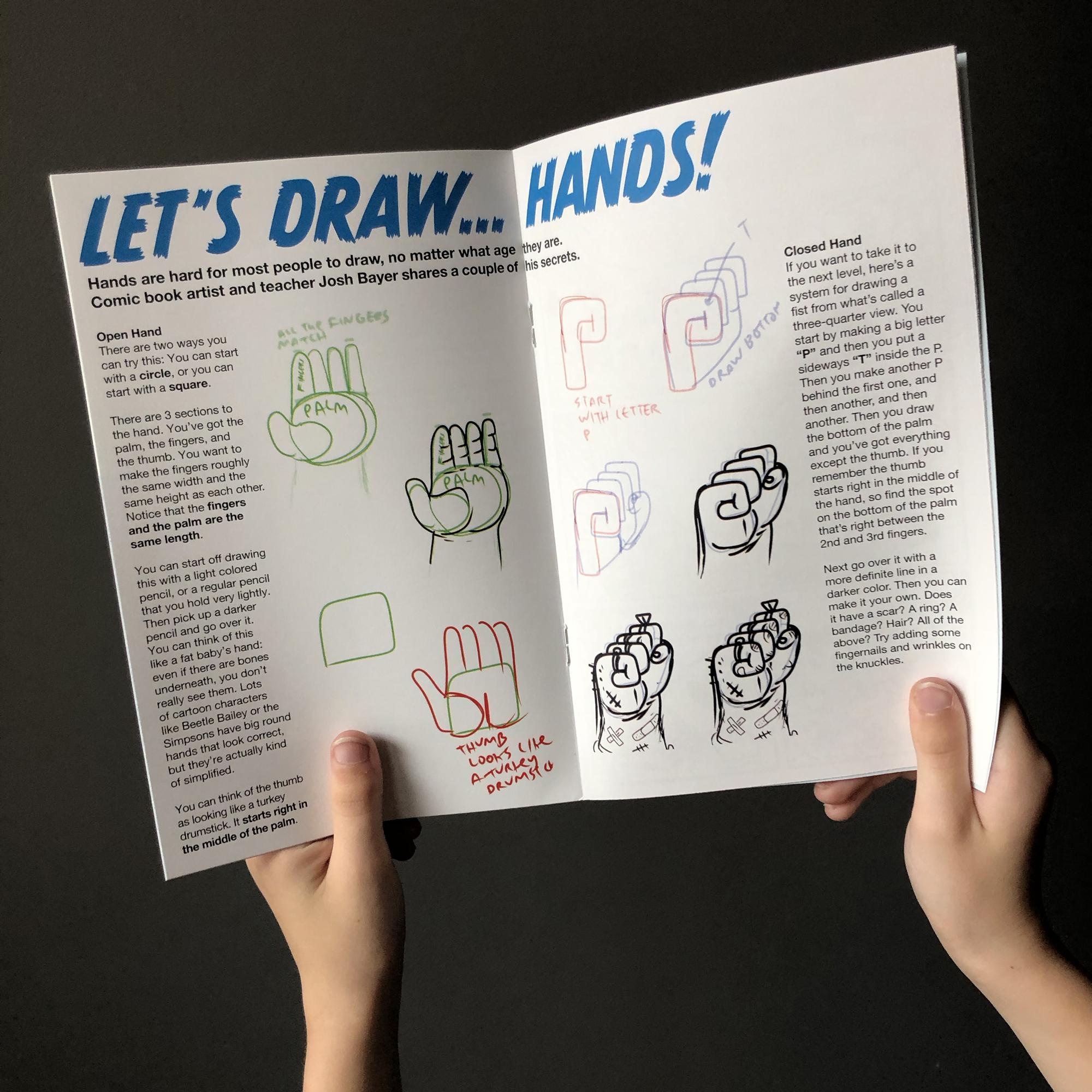
How to Draw Comics the Josh Bayer Way
To produce the first issue of the zine, I called on friends to do cover art, spot illos, and to help develop various writing and drawing activities. I wrote a profile of the creator of that month’s graphic novel selection, as well as a little feature on emanata, and a made list of other recommended graphic novels for kids. It was a mere 12 pages and was way more work than you’d think! It was also way more expensive than I needed it to be–and that was with everyone (very kindly) working for much less than they were worth. In our first month, we only had 27 subscribers–people who joined as a result of word of mouth or my son and I handing out flyers from our sidewalk stand–so that first 12-page issue of the zine actually cost more than the 100+ page graphic novel it accompanied. A lot more.
Obviously that’s not sustainable, and the only way to make it all work was to get those subscription numbers up, which of course was the whole idea! But how? Here’s what we’ve done so far:
We worked to drive people to our own ecommerce-enabled website: We launched our subscription box through a Squarespace website. In hindsight, I wish we’d gone with another service because Squarespace, while being handy for web design and for basic online selling, has serious shortcomings in terms of tax collection and customer account management. The most serious flaw being that customers can’t change (or correct typos in) their address. Squarespace customer support actually says that this is solved by telling customers to cancel their subscriptions and re-join with the correct info, which is insane, considering one of the challenges we’re talking about here is trying to get people to subscribe. Let’s get back to that–how did we do it?
•Social media: blah, blah, blah–we all know how to use social media.
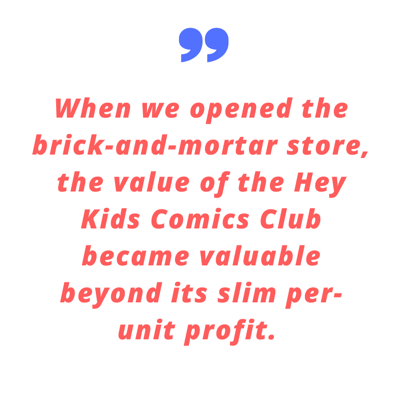
•We ran print ads in comics fanzines: I love zines like Bubbles and Strangers, and thought their readers might be into what we were doing. I’m not sure it worked, but at least we supported some great publications and raised awareness of our existence!
•Earned media (aka “press”): Nothing, and I mean nothing beats a write-up or video piece on an existing website / local tv station, etc. Our first little press hit came courtesy of Boing Boing, and we immediately saw a jump in subscribers. An Instagram post from our neighborhood’s favorite news outlet, Greenpointers, led to even more. It works better than paid advertising because it is not advertising. So how do you make it happen? You ask. Pitching yourself takes time, energy, and a bit of chutzpah, but it works.
•We sold through Cratejoy: We listed the Hey Kids Comics Club on Cratejoy in hopes that people who were specifically shopping for subscription boxes might like what we had to offer. The space you have to pitch your product is limited, but I have to say that it has worked. We continue to see subscriber growth through Cratejoy, and their dashboard makes everything plain as day, their integrations with shipping software always work, and their customer support is great.
•We sold through Amazon’s Subscription Box program: Amazon launched a subscription box platform a couple of years ago. You have to apply to participate, which I did. Even after we were accepted it was about 3 months before all of the technical glitches were sorted out. We had some subscribers join via Amazon, which is actually surprising because we sure as hell didn’t come up in their search unless you had actively chosen the subscription box category. I thought that in selling via Amazon we might really ramp up our subscription numbers–reducing the per unit cost of producing the zine–and making the hefty fees that Amazon takes (15% + $1.80 “closing fee” + $39.99/month for their “Professional Account” ) worth it. But as of this month, we decided to pull the plug on dealing with Amazon. We were actually losing money on each sale. Overall, it felt like a racket designed to get us to spend ad dollars to improve our search results, but even when we were willing to go along with this “gotta spend money to make money” approach, they consistently failed to deliver our ads and would end up billing us like 30¢.
So How Did it All Shake Out?
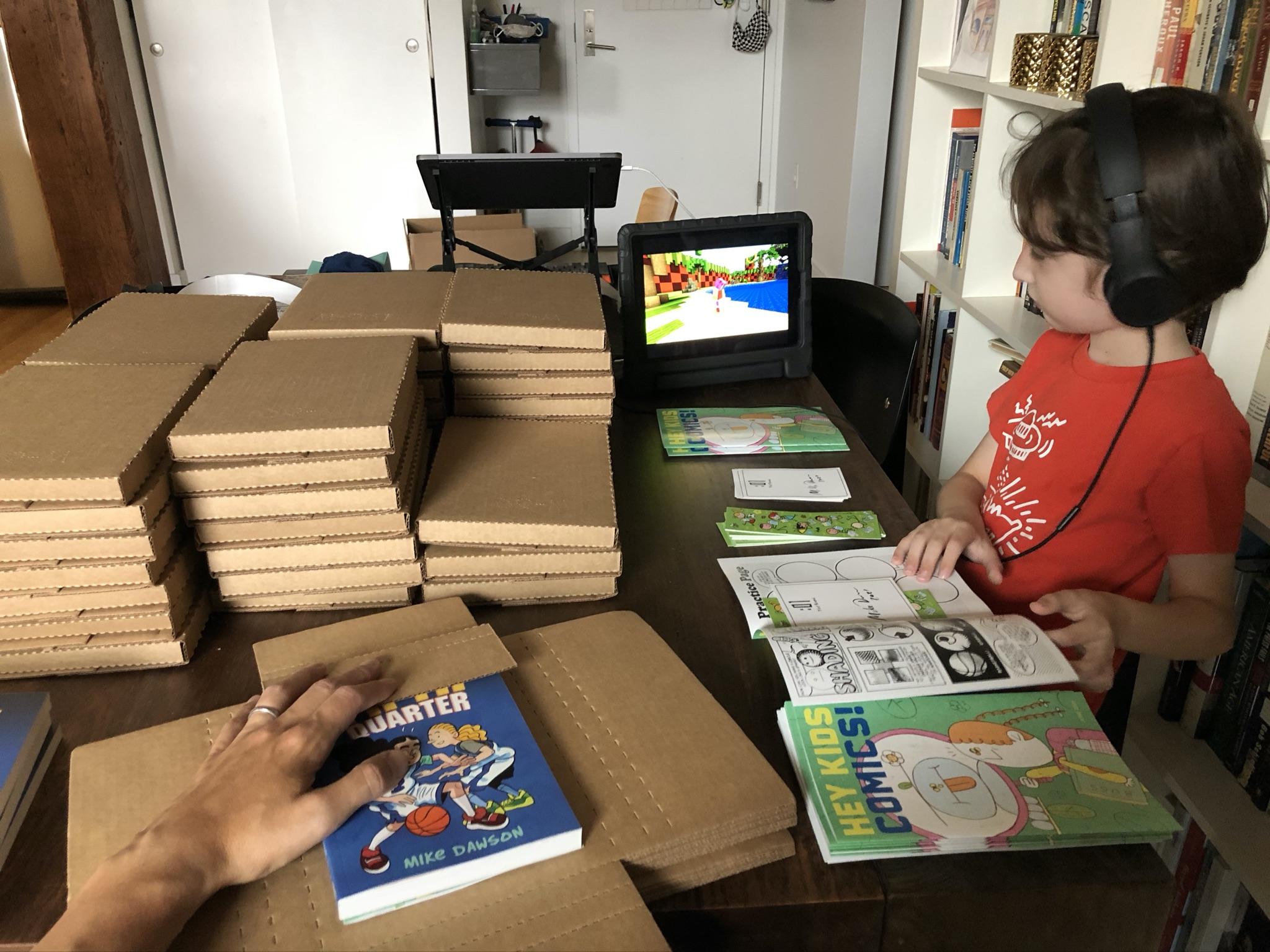
The pre-store assembly line, June 2021
Well, in short, it took a lot longer to get to a break-even point than I expected, but I’ll take slow-and-steady growth over decline any day. It’s a lot of work for little profit. Now, with the right online advertising skillz, you could take something that has even a slim profit margin and make a lot of money on it–you just need to know how much a sale (aka “conversion”) is worth, and adjust your budget accordingly. But since I’m selling a subscription rather than a single product with a definitive margin, it’s hard to say how much each subscription is “worth.” That all depends on how long they keep their subscription active. Is it a year? Two years? Three months? I don’t yet have enough data to paint a picture of “average,” so like a distiller attempting to make a good bourbon for the first time–it looks like I’m just going to have to wait a few years.
That said, when we opened the brick-and-mortar store, the value of the Hey Kids Comics Club became valuable beyond its slim per-unit profit. First off, offering in-store pickup means that we have a group of customers who are swinging by the store at least once a month. Since our store doesn’t benefit from the Wednesday warriors coming through, it’s incredibly helpful to have something else that brings kids and their parents to the store on a regular basis. That our little store also runs this cool club and produces a cool zine that introduces kids to the people behind their favorite comics does give the shop a bit of cachet. Building off of that, we have the opportunity to market the club to customers in person via an in-store display, promotional bookmarks, and good old-fashioned chit-chat; Making an otherwise impersonal subscription box something that people have a real-world connection to (which makes it a more thoughtful gift when they ultimately give it as a gift to their out-of-state relatives).
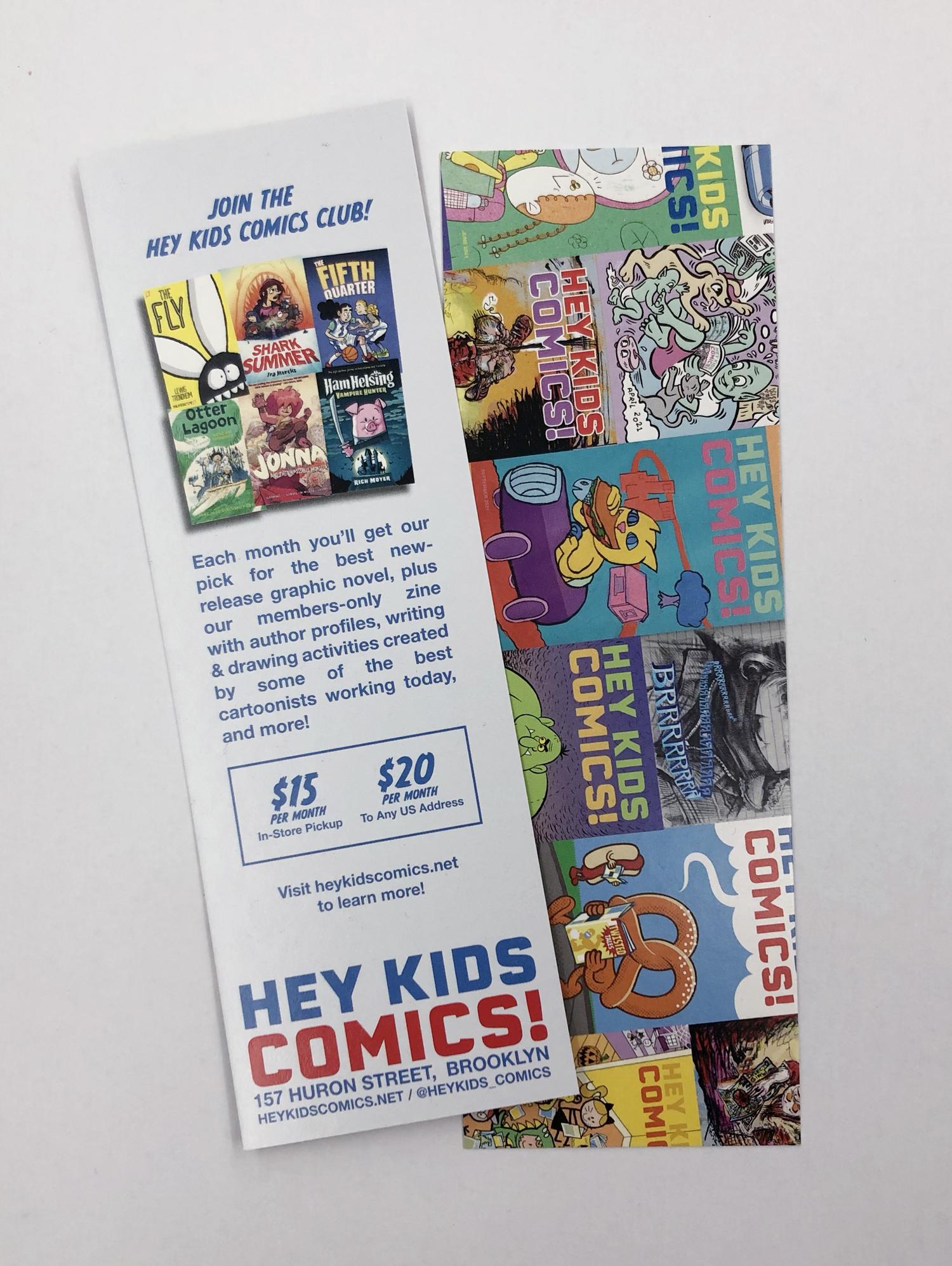
Promo bookmarks that we drop into each book we sell at the shop
Another way the club became more of an asset when we opened the store was the recommendations we always ran in the zine could now become a source of revenue. We joined the American Booksellers Association and became a platform seller on Bookshop.org. Basically, what that all means is that we have a Hey Kids Comics storefront on the site and earn a nice commission on sales–sales that are fulfilled entirely by Bookshop.org. Being able to offer our customers a way to get the books we were suggesting in a way that benefited us rather than Amazon is pretty great.
Last but not least, it did turn out to be a lot of fun! I love making picks, and getting the chance to interview comic creators like Chris & Laura Samnee, Kelly Fernández, and Lewis Trondheim to name a few. It’s been fun to work with my favorite comic artists, local artists from the neighborhood, and people who I’ve only met because they like what we’re up to and took the initiative to drop a note over the transom.
Heck, even packing up the zillion boxes myself is kinda fun. It’s certainly something to do on those slow days rather than looking longingly at the front door.


